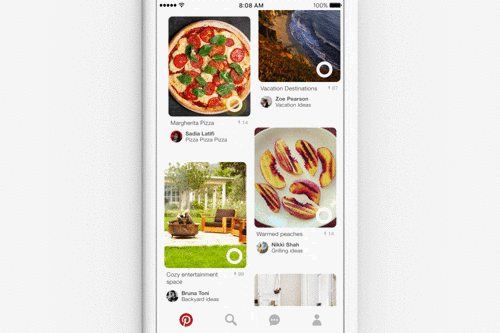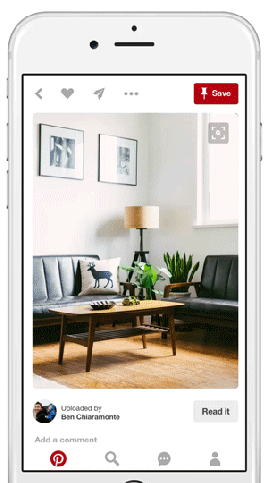Pinterest made a clear declaration of intent last week with the announcement that Li Fan, Google’s former head of image search, has joined the photo sharing site as Head of Engineering.
This appointment is reflective of a strategy to challenge both Google and Amazon in the product-based visual search market. Notably, Pinterest also rolled out their paid search offering, driven initially through a partnership with Kenshoo, in 2016.
Due to the glacial pace of advertising product launches from Pinterest over the past few years, some in the industry felt their opportunity to monetise their user base may have passed.
Moreover, the keyword-based paid search market is saturated as it is, with Google constantly trialling new ways to eke out more searches.
However, in many of the potential growth areas for the industry, such as voice search, personalisation, and most obviously, image search, Pinterest believe they have something different to offer.
As a social platform focused more on nourishing the self than sharing selfies, Pinterest is inherently driven by the power of images. Nonetheless, the history of image search has shown that mastering the requisite technology to tap into this potential is no mean feat.
How Pinterest plans to tackle visual search
On February 7, Pinterest launched their new Visual Discovery Tools, including Lens. Built into the Pinterest app, through Lens users can point their camera at an item and the app will make suggestions based on what it sees. Point the camera at some asparagus, for example, and the app will suggest some recipes.
This is a further stage of development from Amazon’s Firefly (available through the Amazon app), which can recognise objects and suggest similar items to purchase, but is not yet able to make the conceptual leap to suggest complementary products or ideas.
Pinterest posted the following in relation to the Lens launch:
“Sometimes you spot something out in the world that looks interesting, but when you try to search for it online later, words fail you. You have this rich, colorful picture in your mind, but you can’t translate it into the words you need to find it.
At Pinterest, we’ve developed new experimental technology that, for the first time ever, is capable of seeing the world the way you do.
It’s called Lens (currently in beta), and it lets you use the camera in your Pinterest app to discover ideas inspired by objects you see out in the real world.”
This is in beta and works best with food, clothing and decor at the moment, but the possibilities are endless if the technology continues to develop. With an estimated 75 billion Pins to sift through, it may take a while.
However at Pinterest, there is clearly a belief that cracking visual search can start to bridge the gap between language and the world around us.
The fact that they routinely refer to ‘idea searches’ rather than ‘keywords’ is indicative of this focus on adding a new spin to a deeply-ingrained feature of internet usage. This is intriguing on many levels, but strikingly it may offer a new avenue for advertisers to engage with consumers at an optimal time, through the ideal medium.
Pinterest and ad blockers
This leads on nicely to the current ad landscape, one in which many internet users have resorted to ad blockers to avoid overbearing messaging.
Another stated aim at Pinterest is to re-frame ads as a welcome way to discover new ideas, concepts and products, rather than an intrusion into a user’s browsing experience.
An advertiser’s product feed, if synced to Pinterest’s image search algorithms, could deliver increasingly timely and relevant results to users. Where this becomes most compelling is in the ‘related searches’ that Pinterest provides. So for example, a search for shoes could also provide recommendations for the rest of an outfit.
If advertising can become synonymous with the discovery of new and exciting ideas, it suddenly seems much more appealing to the consumer. As such, consumers could be much more willing to jettison their ad blockers and engage with promoted results.
This is a tall order and perhaps quite a utopian aspiration at this stage, but the theory is seductive nonetheless.
Offering an alternative to Amazon and Google
Much has been made of Amazon’s continued rise in the search market, and an oft-cited 2016 survey from Power Reviews placed them as the preferred starting point for product searches among US consumers.
This was particularly newsworthy for the fact that it relegated Google to second place. The battle for supremacy in such a profitable arena has only intensified since, with commercial searches the main prize.
The most interesting aspects of this – and where Pinterest comes back into the fray – are the reasons why Amazon has taken this lofty position.
Predictably, variety of products ranks as the most popular reason, followed by free shipping and competitive pricing.
Amazon led with these value propositions and they continue to drive the company’s success, even with the advent of more innovative home technologies like the Echo and Echo Dot.
Google has been at pains to streamline its purchasing processes too, in search, shopping, and their rival to the Echo, Google Home.
What these platforms ultimately provide to the consumer is a frictionless way to purchase products from reliable sources. The consumer knows what they want and they reveal this by searching for it, and companies are willing to pay for the chance to get in front of customers at this high-intent purchase stage.
But there is more to some product-consumer relationships than just a seamless transaction, and it is one that either Google or Amazon would have to work hard to avail of in its entirety.
Pinterest’s competitive advantage
Pinterest has the enviable asset of an engaged user base, not on the premise of deals or free shipping, but on the experience the platform allows them to create and the ideas it allows them to access.
Pinterest may not be a credible threat when it comes to some clear transactional searches, where the consumer knows what they want and is really looking for a comparison, by price or by review ratings. But this seems very unlikely to be Pinterest’s natural marketplace anyway.
It would be very interesting to segment the Power Reviews survey results further to understand the different categories within product searches. The act of searching can be nuanced; it implies uncertainty and a desire to be provided with an answer.
The answers Pinterest can provide, if technologies like Lens take hold and it delivers on the enticing promise to read the world through visual search, will go far beyond a traditional list of links and images, and into the realm of something much more inspirational for consumers.
As such, it would be fascinating to know how many product searches, whether on Google, Facebook, Amazon or Pinterest, fall into this category. Or perhaps more appropriately, how many searches would fall into this category if people knew the technology existed.
Combined with the one-click purchase technology Pinterest plans to integrate worldwide, this would see Pinterest tick many of the boxes that shape the ‘Why Shoppers Start on Amazon’ graph featured above, and also generate new demand.
Consumers can be fickle and if they prize the variety of products on offer (as evidence suggests they do), the platform that provides this will become their preferred destination. If it can do this by resolving the awkward paradox inherent in ‘traditional’ image search (using words to search for images, often with unconvincing results), it will be all the more attractive and effective.
Advertisers, of course, will follow where consumers go, especially if Pinterest continues to develop their paid search offering through 2017.
Delivering better search results through new technology and a growing pool of users is a model ripe for monetisation, a possibility not lost on Pinterest. For luxury goods, home decor, and fashion companies, this platform seems a natural fit and it would not be surprising to see these brands among the early adopters of paid advertising on Pinterest.
What does the future hold for Pinterest?
Attention spans are a precious, dwindling commodity, and simply shouting at consumers just won’t cut through.
By connecting to, and enhancing, our experience of the world around us, Pinterest may be in a position to steal a march on the competition – in technological terms, at least. A monthly user base of 150 million lags behind the giants in this arena and Pinterest will not gather the clout to tackle Google for Search dominance, but its development is no less compelling for that.
Ours is an increasingly visual culture, and Pinterest is well placed to challenge on the basis of the big focal points in search today; local, personalisation, voice, image, video, and app integration. It also offers a different experience to users that potentially allows advertisers to sell without intruding.
That makes for a potent combination and, should it all come together as planned, could see Pinterest offer a welcome alternative to Google and Amazon for marketers and consumers alike.
source https://searchenginewatch.com/2017/02/16/will-pinterest-crack-and-monetise-visual-search/









No comments:
Post a Comment